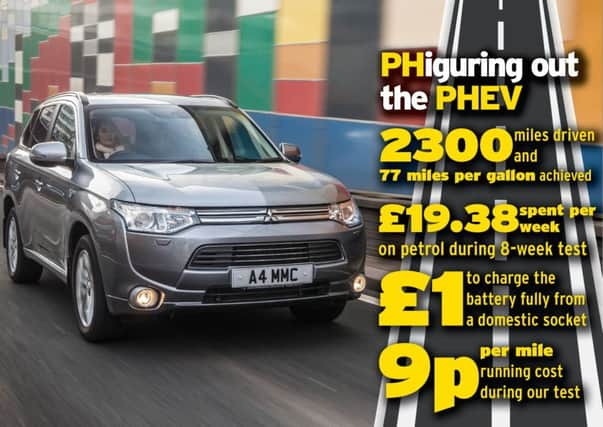Long-term test: Figuring out the Mitsubishi Outlander PHEV


If I’m honest though, I am probably pretty average in most respects. Sorry, Mum. I’m of pretty much average height at 5’ 8”, my prowess on the football field was unremarkable save for a purple patch at age 11 and at karaoke I can carry a tune but a recording career does not beckon. I own an average car (Mondeo), live in an average house (three-bedroom semi) and my professional role is classed as middle management. I’m Mr Average.
Which hopefully makes me the right man to test how the Mitsubishi Outlander PHEV performs in the hands of the average driver.
Advertisement
Hide AdAdvertisement
Hide AdThe Japanese firm makes some pretty remarkable claims about the hybrid version of its Outlander SUV, the most eye-catching of which is the claimed 148mpg on the combined cycle which, if you’re contemplating buying a hybrid, is no doubt the first thing you’ll be drawn to in the sales spiel.
But anyone who has been reading road tests for any length of time, in fact anyone who has been driving for any length of time, will know that you need to take manufacturer claims about fuel efficiency with a pinch of salt.
Sure, your reasonably priced hatch-back can do 60mpg in a German wind tunnel with an empty boot, the air conditioning off and windows up. But, to paraphrase Alan Hanson, “can it do the business on a wet Tuesday night in Fife?”
The PHEV has been wafting me around in quiet comfort for eight weeks or so now, and despite a difficult start – when it became clear that my natural driving style was not going to produce world-saving efficiency figures without some adjustment – I have grown to appreciate the charms of this big, comfortable and quiet car. In that time, I’ve covered 2300 miles and experienced most of the situations the average UK driver is liable to during a typical two-year lease deal.
The bulk of those miles have been clocked on my 30-mile round commute, but I’ve also taken in the school run – well, the nursery run — and longer distance trips from the central belt to Aberdeen, Dunkeld, Leeds and Glasgow. I’ve transported four passengers in comfort and the boot has swallowed everything from the weekly shop to Tenerife-bound suitcases, three sets of golf clubs and a child’s bicycle.
As I touched on in my previous feature, a driver who doesn’t leave the 32-mile EV-only range of this car can actually far exceed the 148mpg figure, never using a drop of petrol during their short-range forays across the local road network. But what does the average man, with an average mix of journey types, get in terms of economy figures from the Outlander when he applies his size nine loafers to the accelerator?
Well, to date, I’ve filled the 45-litre tank up twice from empty and the car had a full tank on delivery. That equates to 135 litres of fuel used for approximately 2300 miles. If, rounding down, one gallon is 4.5 litres, then I have used 30 gallons of fuel. So I’ve achieved 77 miles per gallon driving the equivalent distance of a journey from London to Reykjavik and back.
For an 1810kg SUV, that’s not average. That’s great.
Money Matters
MPG and C02 figures are all well and good but, when it boils down to it, running costs are what matter to the majority of road users.
Advertisement
Hide AdAdvertisement
Hide AdDuring this test, the petrol price has hovered around the £1.16 per litre mark and I’ve used just over £155 worth of fuel.
That means the PHEV has cost me just £19.38 per week in petrol money.
A full electric charge costs approximately £1, so call that £26.38 a week.
I’ve averaged 287.5 miles a week, so that figure translates to 9p per mile.